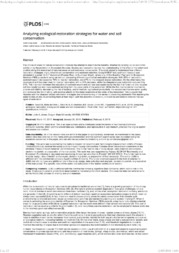Analyzing ecological restoration strategies for water and soil conservation.
Analyzing ecological restoration strategies for water and soil conservation.
Author(s): SAAD, S. I.; SILVA, J. M. da; SILVA, M. L. N.; GUIMARAES, J. L. B.; SOUSA JUNIOR, W. C.; FIGUEIREDO, R. de O.; ROCHA, H. R. da
Summary: Abstract: The choice of areas for nature conservation involves the attempt to maximize the benefits, whether by carrying out an economic activity or by the provision of Ecosystem Services. Studies are needed to improve the understanding of the effect of the extent and position along the watershed of restored areas on soil and water conservation. This study aimed to understand how different restoration strategies might reflect in soil conservation and sediment retention. Using InVEST tool, sediment transport was simulated in a small 12 km2 watershed (Posses River, in Southeast Brazil), where one of first Brazilian Payment for Ecosystem Services (PES) projects is being carried out, comparing different hypothetical restoration strategies. With 25% of restoration, sediment export decreased by 78% for riparian restoration, and 27% for the steepest slopes restoration. On the other hand, the decrease in soil loss was lower for riparian restoration, with a 16% decrease, while the steepest slopes restoration reduced it by 21%. This mismatch between the reduction of sediment export and soil loss was explained by the fact that forest not only reduces soil loss locally but also traps sediment arriving from the upper parts of the watershed. While the first mechanism is important to provide soil stability, decreasing the risk of landslip, and to maintain agricultural productivity, the second can improve water quality and decrease the risk of silting, with positive effects on the water reservoirs at the outlet of the watershed. This suggests that Riparian and the Steepest Slopes restoration strategies are complementary in the sense of preventing sediments from reaching the water bodies as well as protecting them at their origin (with the reduction of erosion), so it will be advisable to consider the two types of restoration.
Publication year: 2018
Types of publication: Journal article
Unit: Embrapa Environment
Observation
Some of Embrapa's publications are published as ePub files. To read them, use or download one of the following free software options to your computer or mobile device. Android: Google Play Books; IOS: iBooks; Windows and Linux: Calibre.
Access other publications
Access the Agricultural Research Database (BDPA) to consult Embrapa's full library collection and records.
Visit Embrapa Bookstore to purchase books and other publications sold by Embrapa.

